Tower’s 12 oldest bells, first played a century ago, to be celebrated
The first dozen bells installed in the Campanile were first played 100 years ago this week
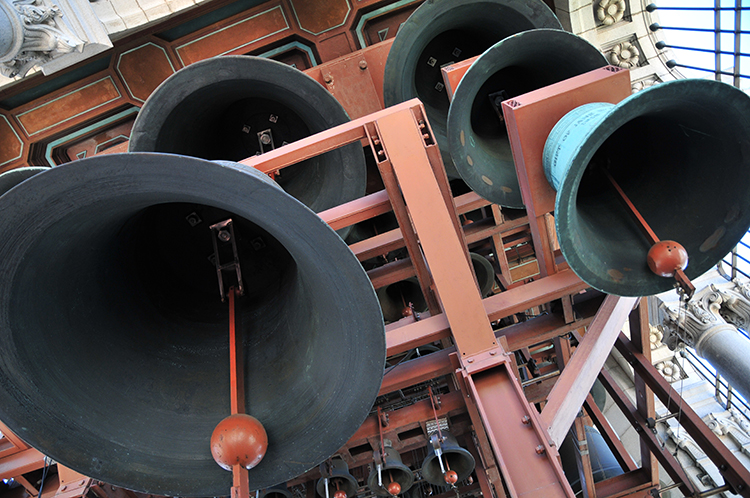
November 2, 2017
If it hadn’t been for the “Star-Spangled Banner,” Berkeley’s Campanile might have only 12 bells in its belfry instead of 61.
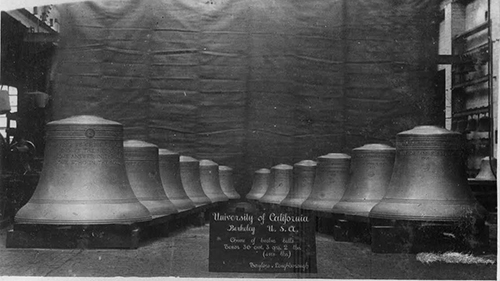
The Campanile’s first 12 bells were cast by John Taylor & Co., a foundry in England. Each is inscribed with “Gift of Jane K. Sather,” and one bears the university seal and the motto “Let there be light.” (Photo courtesy of John Taylor & Co. Bell Foundry Museum)
“There weren’t enough bells in the tower to play the national anthem,…and that was considered a deficit,” says Jeff Davis, university carillonist. “It’s what prompted the Class of 1928 to enlarge it from a chime to a carillon.”
In early 1911, UC benefactress Jane Sather provided funding for the Jane K. Sather Campanile and the 12 bells. Thirty-six bells were added in 1978 by the Class of ’28, and another 13 bells joined the group in 1983 through a gift from alumni Jerry and Evelyn Chambers.
But starting this Friday, those first dozen bells — cast in England during World War I by the John Taylor & Co. bell foundry and hung in fall 1917 — will get their own celebration on the 100th anniversary of their campus musical debut. They were rung at a Nov. 3, 1917 Cal-Washington football game – like all Cal football at the time, the home game was played not too far from the tower on California Field, where Hearst Memorial Gymnasium now stands – and West Berkeley factories responded with their bells and whistles.
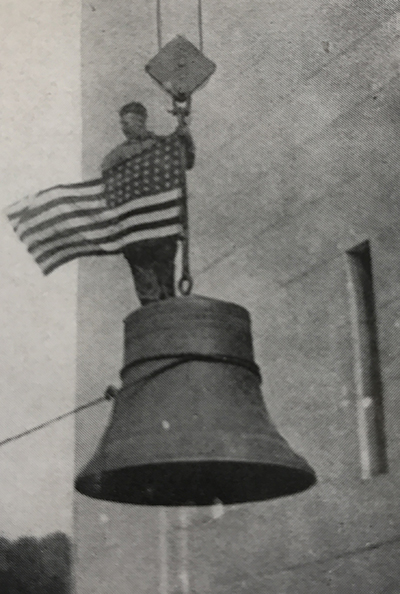
A 1917 photo in Berkeley’s Blue & Gold yearbook shows the first bell being hoisted into the tower.
This milestone in the Campanile’s history will be marked tomorrow, Nov. 3, with music played on the original 12 bells at 7:50 a.m. and noon. The tunes will be from the two-volume “Berkeley Chime Book” in Davis’s office in the tower. The book contains original arrangements by former UC musicians of patriotic anthems, African American spirituals, Cal spirit songs and other tunes.
The festivities continue on Sunday, Nov. 5, at a 2 p.m. carillon concert by associate carillonist Wesley Arai. Davis says a mini carillon festival will be held next summer as part of the celebration.
“We’ll start with music written solely for the original 12-bell chime, then concerts using the enlarged, 48-bell concert carillon and, finally, ones that use all the bells of our grand carillon,” says Davis. He adds that he’s writing a “large, new work, yet unnamed, but well under way,” for carillon and mixed media that will be finished by the end of 2018.
Although the Campanile opened in 1916, the bells didn’t arrive until fall 1917. Their journey to America was delayed by World War I, when British vessels, like the cargo ship the bells were on, were at risk for German submarine attacks.
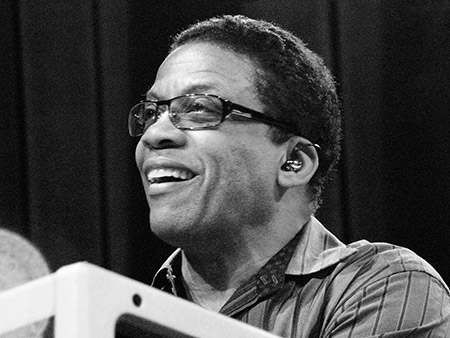
Herbie Hancock, pianist with the Miles Davis Quintet, played the bells in 1968 at a student-run festival. (Photo by Stuart Brinin)
While 12 bells didn’t prove adequate for songs with many notes, the chime still drew some famous musicians to the Campanile in past decades. During the early 1940s, famed blind jazz pianist Alec Templeton played swing songs on Berkeley’s chime during the UC Jazz Festival. In 1961, minimalist musician and then-Berkeley student Terry Riley performed on the bells. And pianist Herbie Hancock gave a 10-minute chime concert in 1968 as part of the UC Jazz Festival.
Bells’ future depends on fundraising
The Campanile is home to the most extensive carillon teaching program at a U.S. university with a bell tower. Davis is training a new generation of carillonists — about 15 to 20 each semester — who also teach their peers how to play the bells through DeCal, a program in which university students create and teach their own classes on a variety of subjects.
The carillon is a special source of pride, spirit and tradition for the entire campus community, says Chancellor Carol Christ.
“Perhaps nothing so strongly and movingly identifies the Berkeley campus as the sound of the Campanile’s bells,” she says. “They mark the hours and rhythms of the day in a way that reminds us all of the community we share; they are the music of Berkeley.”
But Davis says the carillon won’t be operable in as few as five years if the rusting mechanism that activates the clappers that strike the bells isn’t replaced.
“This mechanism wasn’t the best that was available at the time,” says Davis, “and some parts — the roller bars — are positioned so close together that you can’t get a tool in there to knock the rust out. The bars also have bent — they’re no longer straight, but arched — and that makes the carillon increasingly difficult to play.”
In addition, Davis says, the keyboard needs replacing, and the clappers must undergo a heat process to protect them from wearing. The treble bells, which he says are “among the most beautiful treble bells in the world,” should be relocated to the top of the carillon so that their sound can bounce off the coffered ceiling and down to the ground, where currently it’s hard to hear them.
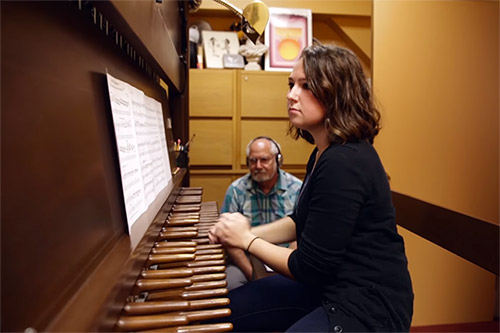
Davis works with carillon student Alyssa Kehlenbach in a practice room in the tower. (UC Berkeley photo by Phil Ebiner)
Says Davis, “We’re looking at $1.5 million, at least.”
Davis adds that the carillon “is the only thing on campus that affects everyone. Most people tell me that when they think of Cal, they think of the sound of the bells and the tower. It’s iconic to them.”
“It’s something that everyone who steps onto the campus shares,” agrees Ed Campion, chair of the Department of Music. “And thanks to Jeff, it’s also very forward-looking and contemporary in its activities.”
Campion says he’s glad that, thanks to an endowment, Davis’ full-time carillonist position is “guaranteed far into the future” as is funding for carillon festivals. He adds that that the music department is doing all it can to support development efforts to service the mechanisms of the carillon.
To contribute to the carillon’s refurbishment, contact the music department at 510-643-8723 or make a gift online to the Carillon Instrument Fund.